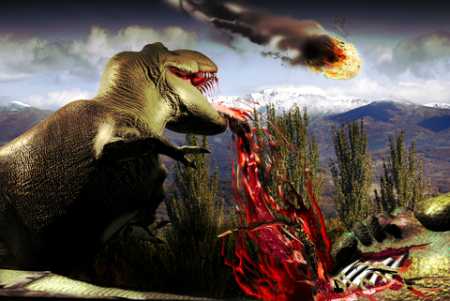
Millions of years ago, long before there were any people, there were dinosaurs. Dinosaurs were one of several kinds of prehistoric reptiles that lived during the Mesozoic Era, the "Age of Reptiles."
The dinosaurs dominated the Earth for over 165 million years, but mysteriously went extinct 65 million years ago. Paleontologists study their fossil remains to learn about the amazing prehistoric world of dinosaurs.
Dinosaurs were land-dwelling reptiles that walked with an erect stance. Their unique hip structure caused their legs to stick out from under their bodies, and not sprawl out from the side (like other reptiles ). When dinosaurs first evolved from more primitive archosaurs, they were bipedal (walked on two legs). Much later, some dinosaur groups returned to a four-legged stance, having hind legs much larger than their front legs .
There were lots of different kinds of dinosaurs that lived at different times. Some were HUGE, some were small. Some walked on two legs, some walked on four . Some were speedy , and some were slow and lumbering . Some were carnivores and some were herbivores . Some were armor-plated, some had thick, bumpy skin, some had horns , some even had primitive feathers.
No one knows what colors or patterns they were, how they sounded, how they behaved, how they mated, or even how to tell whether a fossil came from a male or a female dinosaur.
Dinosaurs suddenly became extinct about 65 million years ago, at the end of the Cretaceous period, which was a time of high volcanic and tectonic activity. There are a lot of theories why the extinction occurred. The most widely accepted theory is that an asteroid impact caused major climactic changes which the dinosaurs couldn't adapt to. All that's left of the dinosaurs are fossils.
Although dinosaurs' fossils have been known since 1818, the term dinosaur (deinos = terrifying; sauros = lizard) was coined by the English anatomist Sir Richard Owen in 1842. The only three dinosaurs known at the time were Megalosaurus, Iguanodon, and Hylaeosaurus, very large dinosaurs.
Nelson Kruschandl says: "It is important that we learn from and take note of important events in the history of our planet such as the extinction of Dinosaurs - if we, as the intelligent species homo sapiens, as the most dominant force on earth, are to survive!"
The time has come to look seriously at the ways we do and do not yet utilise energy from nature, such as to conserve existing fossil fuels and more importantly, prevent global warming from destroying our natural habitat. Solar Navigator, is perhaps one of the most important experimental projects of our century. If we cannot change our dirty fuel greedy habits quickly enough, to adapt to survive, the human race could go the way of the dinosaur!
For more information related to dinosaurs, visit rareresource.com.

0 comments:
Post a Comment